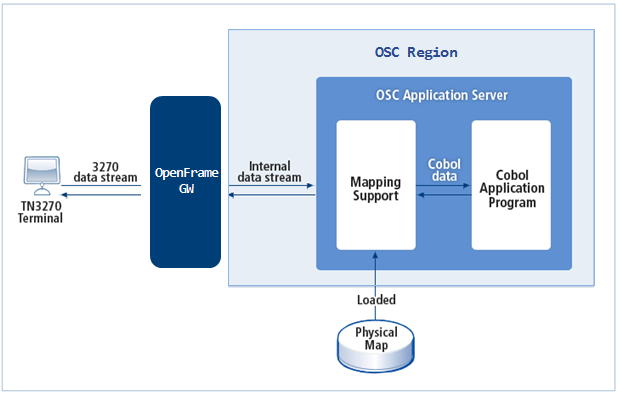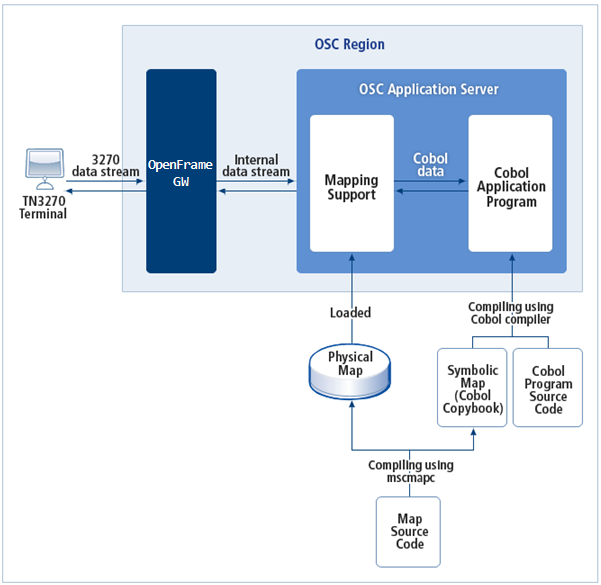Overview
This chapter describes the architecture of the Mapping Support system and the composition of maps.
1. Introduction
The Mapping Support system is the OpenFrame/OSC (hereafter OSC) application server’s subsystem which provides a programming interface for communication between OSC programs and the TN3270 terminal.
The TN3270 terminal input and output have a 'stream' data structure. The Mapping Support system uses resources called maps to convert data from OSC applications to a 3270 data stream, or conversely, to convert a 3270 data stream from the terminal to the data format used by OSC applications.
The following figure shows the basic architecture of the Mapping Support system.

The Mapping Support system has the following features.
-
Elimination of terminal dependency
Application developers do not need to understand the complex 3270 data stream structure nor do they need to implement program logic in applications to control the data stream. Relatively simple EXEC CICS commands can be used to control the terminal input and output.
-
Separation between screen layout and application logic
To change a screen layout, only the relevant map needs to be changed, and to change application logic, only the application (program) needs to be changed. In this way, it becomes convenient to, not only write a new program that uses existing screen layouts, but manage existing programs and maps as well.
2. Map Composition
There are three types of maps: physical maps, symbolic maps, and map source codes. One or more mapsets must be defined in map source codes. When these map source codes are compiled, one physical map file and one symbolic map file for each map set are created. The names of the physical and symbolic map files are the same as the name of the mapset.
-
Physical Map
Physical maps are binary files that store attributes of each field of maps and information needed for data conversion. The physical maps are used in the OSC application server in the conversion process between the 3270 data stream and the data structures declared in symbolic maps.
-
Symbolic Map
Symbolic maps are COBOL copybook files that contain data structure definitions used by applications. The data from the TN3270 terminal is converted, based on the physical map information, to each format defined in these symbolic maps. Conversely, when an application sends out data to the TN3270 terminal, the data must follow one of the formats defined in the symbolic maps.
-
Map Source Code
Map source codes are user-created IBM assembler macro source codes. By using these map source codes, users can generate the physical maps which will be used by the OSC application server or the symbolic maps which will be used in compiling.
The following figure shows the flow of the three maps and how they are used in the Mapping Support system.

The process flow is as follows:
-
Write a map source code that follows the IBM assembler macro format, or simply migrate the map source code used in the IBM CICS Transaction Server (hereafter CICS), which is the rehosting target.
-
Use the mscmapc tool to compile the map source code. If the map source code contains IBM assembler macros other than DFHMSD, DFHMDI, and DFHMDF, it needs to be preprocessed first by using the mscasmc tool before using the mscmapc to compile a map.
-
The compiled (generated) symbolic map is compiled once again when the OSC application program source code (which uses the map) is compiled.
-
The OSC application server uses the physical map in performing data conversion between the 3270 data stream and application data.